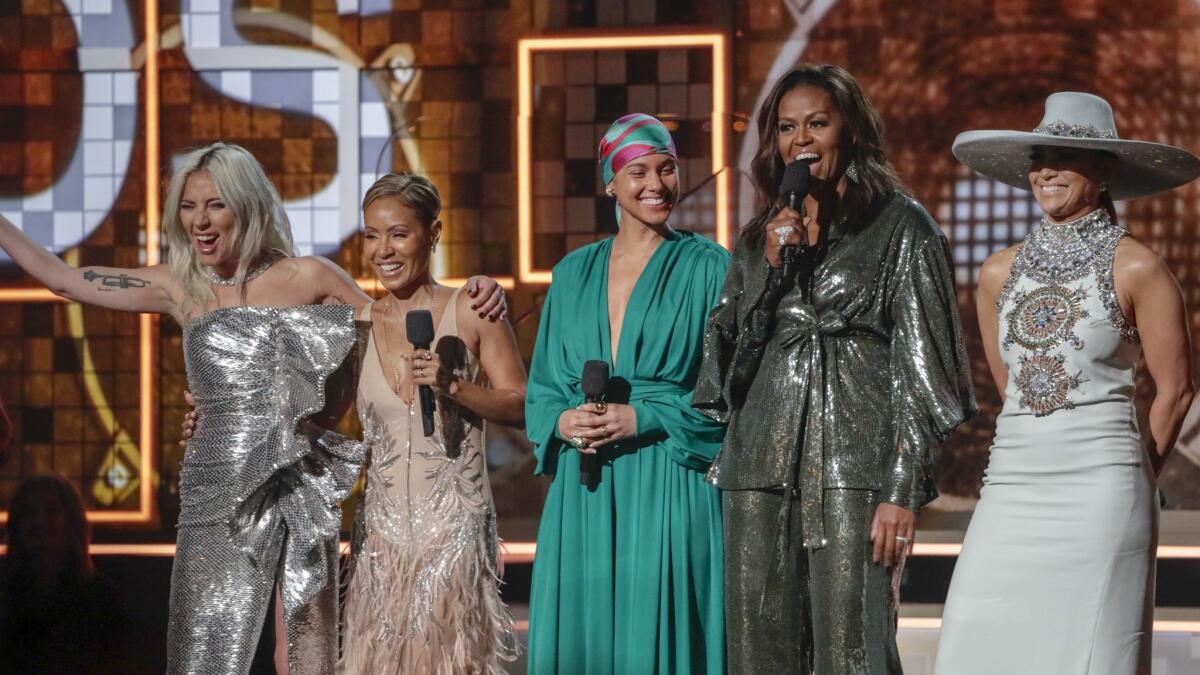New study shows some gains for women in music, but men still dominate pop charts

- Share via
Women in the music business of 2020 are, by some measures, better represented on the sales charts and at the impending Grammy Awards, according to an updated, broad-based study conducted by the USC Annenberg Inclusion Initiative.
Few, however, are likely to frame the latest statistics as good news in light of how overwhelmingly female artists remain at a disadvantage on the pop sales charts and on Grammy night, which arrives again Sunday.
The third edition of the study, spearheaded by USC Annenberg Inclusion Initiative founder Stacy L. Smith, was announced Tuesday, revealing that for 2020, the percentage of female nominees in five of the highest-profile Grammy categories has hit an eight-year high, accounting for nearly 21% of all nominations in those fields.
That’s a striking increase from the second edition of the study published just two years ago. That survey found that barely more than 9% of those nominations went to women. Yet the latest number still demonstrates that four out of five Grammy nominees in those categories — record, album, song, new artist and non-classical producer — are male.
“If you look across all the data for performers, songwriters, producers and Grammys, you see an uptick,” Smith told The Times on Monday. “It’s small, and that’s the problem. But typically, with our work in film and television, you don’t see indicators across multiple areas move in the same direction like this. Within two short years, we’re starting to see some changes.”
The Grammy nomination results are also largely in sync with what the study found in examining gender breakdown of the 100 top songs each year from 2012 through 2019: 22.5% were by female artists, 77.5% by males, a 3.6-to-1 imbalance.
When the 2018 edition of the study came out just ahead of the 60th Grammy Awards, it provided a backdrop for what turned into a #GrammysSoMale protest campaign on social media after male winners dramatically outnumbered females, especially in the prime-time TV portion of the ceremony. Just one solo female musician — new artist winner Alessia Cara — was presented with a Grammy on camera that year.
It also fueled the controversy over the Recording Academy’s then-President and Chief Executive Neil Portnow’s comment backstage after the awards that it was time for women to “step up” to achieve parity with men. It likewise figured prominently in the recently concluded work of an 18-person task force charged with examining gender and racial biases in the music business and within the Recording Academy itself.
One member of that task force was pop star Selena Gomez.
“Almost a year ago, I joined onto the initiative from the Recording Academy’s Diversity and Inclusion Task Force to create opportunities for females in the music industry,” Gomez, 27, said in the same statement. “While recording my new album [“Rare”], I wanted to ensure there were women involved in the creative process. I feel proud that women were essential collaborators on every song whether as a songwriter, producer, or engineer. It’s a start, but there is much work to be done to amplify women’s voices in our business.”
Smith lauded what she referred to as “the Selena effect.”
“Selena’s quote is so important,” Smith said. “You treat every song as a decision. We could dramatically change [what the latest study found] if just 10 artists ensured that at least one individual in all those roles was a woman. We could see a major shift by next year.”
There also were signs of relative success for female musicians of color in the finding. In 2019, artists from underrepresented racial and ethnic groups constituted more than half (56.1%) of the top 100 records, notably above the eight-year average of 45.4%.
“For the last three years, the majority of artists on the Hot 100 year-end Billboard charts were from underrepresented racial/ethnic groups,” the study found. “For women of color, 2018 was an eight-year high (73%). Fully half or more female artists were from underrepresented racial/ethnic groups in 2016 (54%), 2017 (50%), 2018 (73%) and 2019 (55%).”
In the Grammy Awards arena, females have fared best as new artist and song of the year contenders, averaging 36.9% and 24.6% of nominations over eight years studied. Come Sunday, 44.4% of the song of the year nominees are women, and 46.2% of new artist contenders are female.
By contrast, among nominations for overall record of the year (which recognizes vocal performance, production and engineering) and album of the year categories, an average of 8.2% have gone to females since 2012, and just 2.5% for producer of the year, in the form of a single nomination in 2019 for producer Linda Perry.
Looking more broadly to the recordings that have fared best on the Billboard Hot 100, the numbers become significantly more skewed: Last year just 14.4% of the 3,874 songwriters responsible for the most popular 800 songs over the study’s eight-year span were women, a statistically insignificant blip above the eight-year average of 12.5%. That figure has remained nearly static over time: in 2012, 11% of songwriters who crafted the top 100 songs that year were female.
At the same time, the study found that, as Smith noted, the most prolific and successful male songwriters hold inordinate sway over pop music.

“Eleven men were responsible for writing 23% of the songs that appear in our [hit song] sample,” she said. “Eleven men are setting the norm for lyrics in the 800 most popular songs. That’s astounding. To really understand the perspectives of people from a variety of different backgrounds, it’s so important to get artists to bring new voices to the table.”
On that point, there’s been an upward trend for female songwriters of color: “A linear trend emerged depicting a steady increase of female songwriters from underrepresented racial/ethnic groups from 2012 (14 credited women of color) to 2019 (44 credited women of color),” the study said. The percentage overall for white female songwriters fluctuated slightly over those eight years but remained relatively steady in the low 30th percentiles of total female songwriters.
The disparity in the world of record production is even more staggering: 5% of 2019’s top 100 recordings were produced by a woman; the eight-year average is 2.6% women to 97.4% men.
“The music industry has virtually erased female producers, particularly women of color, from the popular charts,” Smith said. “As producers fill a leading creative role, it’s essential to ensure that women from all backgrounds are being considered and hired throughout the industry. Moreover, the industry itself must continue to expand its commitment to representing the voices and talent of women in all aspects of the business.”
More to Read
The biggest entertainment stories
Get our big stories about Hollywood, film, television, music, arts, culture and more right in your inbox as soon as they publish.
You may occasionally receive promotional content from the Los Angeles Times.








